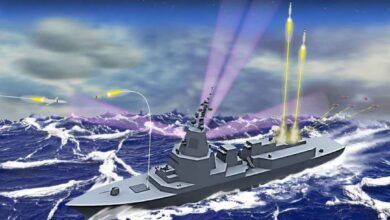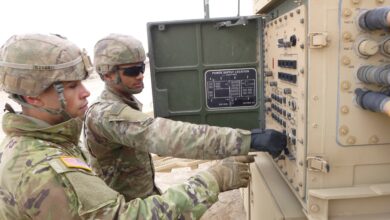
For decades, advanced technology has been a key enabler of US military might, organized through strategic paradigms such as offset strategies. Today, our near-peer competitors and aspirant regional powers have learned our lessons well, seeking to deploy their own transformational technologies.
China is pursuing a national strategy to make it the dominant scientific power by the 2030s and to leverage that technology for military dominance. Meanwhile, Russia has been aggressively investing in radically new defense technologies and building upon its legacy capabilities to once again challenge America.
Simply increasing Department of Defense (DoD) investments to keep pace with these emerging threats is not feasible given the economic and fiscal realities of today. To maintain its technological dominance, the US military will require a new strategic paradigm to ensure our security in the coming decades.
The Joint All Domain Command Control
The Pentagon is now betting on the Joint All Domain Command Control (JADC2) program to provide at least part of this new paradigm. JADC2 is intended to be an “internet of things for the military,” connecting sensors, shooters, and decision-makers across all services and operational domains in near-real-time. Added to that will be advanced information technologies including artificial intelligence and 5G.
The overall concept is to leverage ubiquitous information flows and command/control across all available assets to “self-organize” the best responses for operations in potentially near-machine time.

The scope envisioned for JADC2 will make it one of the largest and most advanced system-of-systems ever created and may present one of the most complicated procurement efforts in recent memory.
Major challenges to technology development, acquisition, integration, doctrine, command authority, cybersecurity, DoD culture, and a range of other areas will no doubt arise. Given the complexity of this task, choosing the right partners for DoD to develop this project will be critical.
Current JADC2 Strategy
The current JADC2 strategy calls for the system to be composed partly from similar multi-domain programs currently under development by the respective branches of the US military. The DoD is a siloed enterprise by culture and design, divided by service, command, and function. Creating such an overarching and pervasive technological behemoth within its existing organizations may be a challenge.
Currently, the budgeting, development, and integration of JACD2 will be overseen by the JADC2 Cross Functional Team, the Joint Requirements Oversight Council, the J-6, and other DoD stakeholders.
While this current process seems to be a roadmap for success to overcome JADC2’s many organizational, doctrinal, and legal challenges, the key challenge will be the technology itself, and how to procure and integrate it.
Non-Traditional Defense Contractors
A particular issue possibly vexing for DoD JADC2 oversight may be the use of non-traditional defense contractors. JADC2 is an IT system at its core, and therefore leveraging startup IT companies (think Silicon Valley) with cutting-edge technologies would appear to make sense.
However, there are known issues when the DoD deals with such companies, for example the uncomfortable experience of the Defense Innovation Unit in which some of the most successful IT companies were averse to working with the DoD.
Moreover, these companies may not have the organization, culture, resources, or experience to ensure the security levels necessary for sensitive DoD projects, or the restrictive schedules and requirements for deliverables. In the freewheeling world of commercial IT companies, development problems or cybersecurity breaches can mean a loss of revenue, but for defense systems, it can mean a loss of lives.
Traditional Core Defense Contractors
The current acquisition strategy for JADC2 is still not clear, but the DoD should strongly consider using the traditional core defense contractors (such as Lockheed Martin, Northrup Grumman, Raytheon, Boeing, and SAIC) as the linchpins of JADC2 RDT&E.
The sheer size, reach, and sophistication planned for JADC2 requires companies whose size, technological sophistication, and history of integrating large defense systems can oversee major portions of JADC2 development and deployment.
Security, both cyber and physical, must also be of paramount importance for JADC2. The core contractors have the experience and systems in place to help ensure optimal security from the industry side.

While the DoD’s proposed use of Lead System Integrators has been criticized at times, DoD authorities can still craft acquisition guard rails and proper oversight to avoid vendor lock and require open-source systems and inclusion of small highly innovative companies.
Without this extensive use of core contractors, the DoD will likely be unable to afford the time, resources, and effort necessary to herd the cats of potentially hundreds of smaller subcontractors and integrate them into an overarching system-of-systems.
Shortest Route to JADC2’s Success
In approving development of the JADC2, the DoD has taken a wise first step in creating a transformational technological capability that could ensure US military dominance for decades. Equally important, both for national security and for the taxpayer, is to craft an acquisition strategy which principally leverages the expertise, culture, and resources of the core US defense contractor.
As Lt. Gen. Dennis A. Crall, CIO/J6 of the Joint Chiefs of Staff, recently said at a Department of Defense press conference, “Talk is good. Now it’s delivery time, and we’ve been given a clear signal to begin pushing these outcomes to the people who need them.”
The tools exist to create a potentially game changing defense capability, but it is paramount for the DoD to choose the right partners to enable the shortest route to JADC2’s success.
 Dr. James Kadtke has nearly 30 years of experience in the areas of science and technology, national security, and business. He has held senior staff positions in Federal government offices four times; including stints in the US House as a technology advisor, the US Senate, and in two White House support offices. He has also held faculty positions in academia, including as an Expert Consultant on emerging technologies at the National Defense University in Washington, DC.
Dr. James Kadtke has nearly 30 years of experience in the areas of science and technology, national security, and business. He has held senior staff positions in Federal government offices four times; including stints in the US House as a technology advisor, the US Senate, and in two White House support offices. He has also held faculty positions in academia, including as an Expert Consultant on emerging technologies at the National Defense University in Washington, DC.
He is also a business owner and business consultant in the private sector and has had staff or leadership positions in several non-profit policy-related organizations. Dr. Kadtke has published over 80 peer-reviewed science articles and has four patents.
The views and opinions expressed here are those of the author and do not necessarily reflect the editorial position of The Defense Post.
The Defense Post aims to publish a wide range of high-quality opinion and analysis from a diverse array of people – do you want to send us yours? Click here to submit an op-ed.










